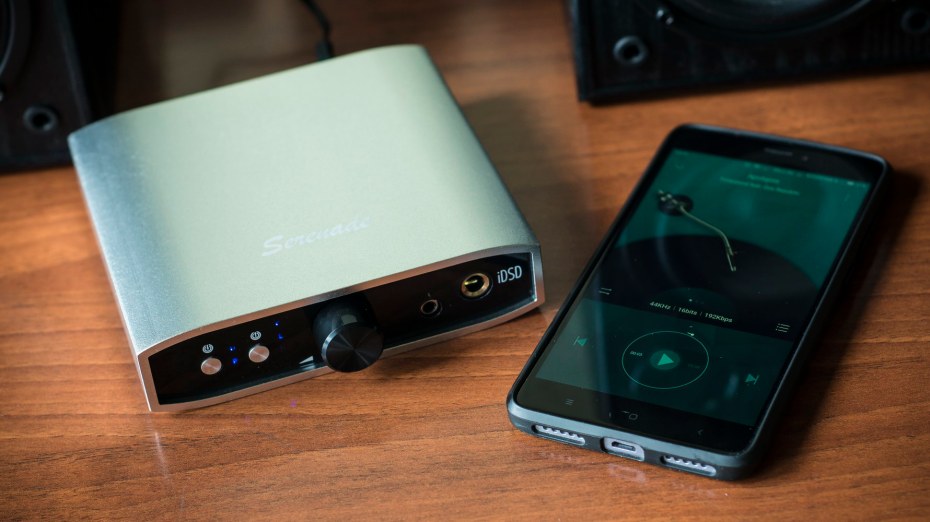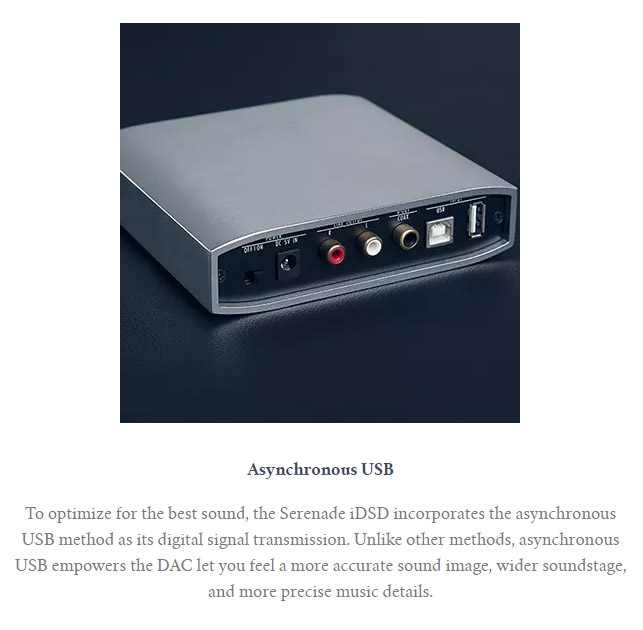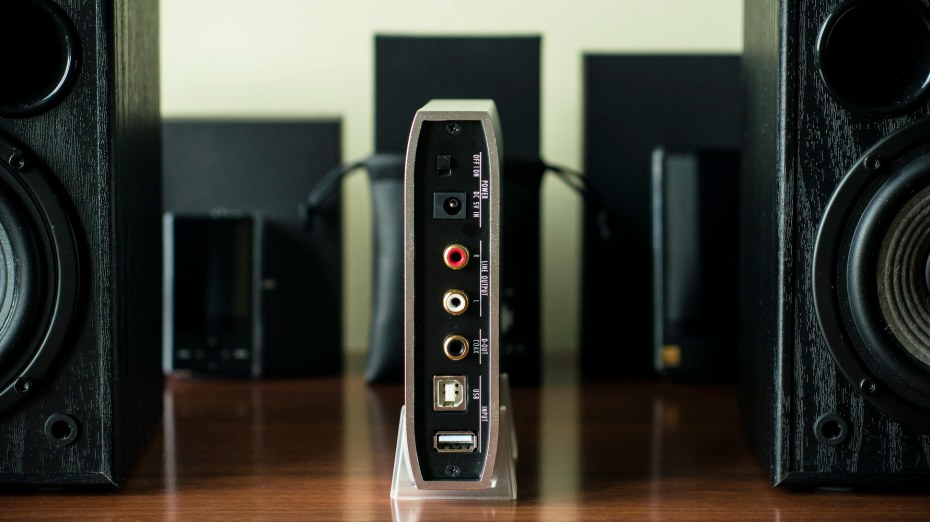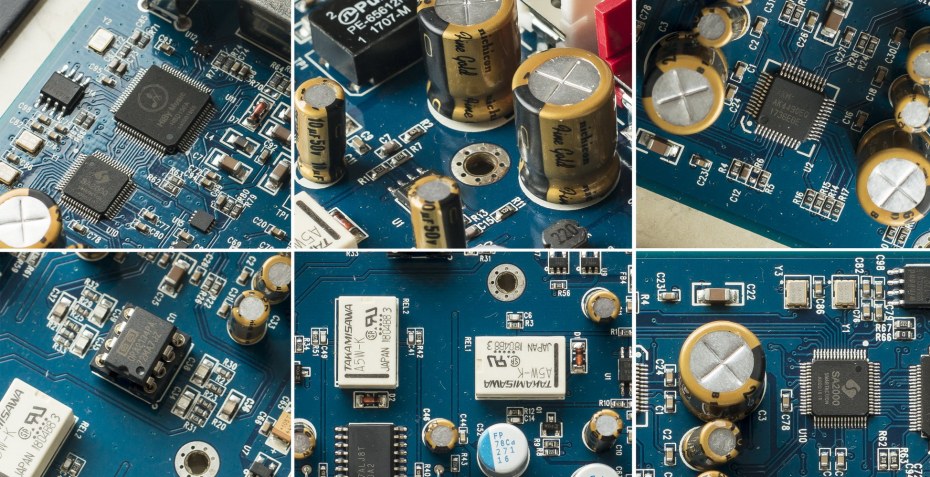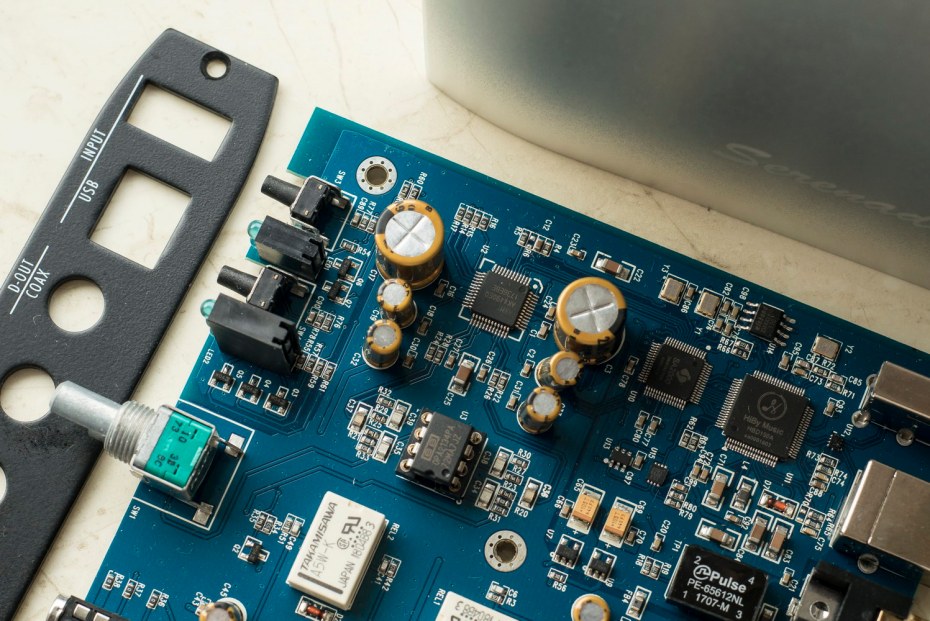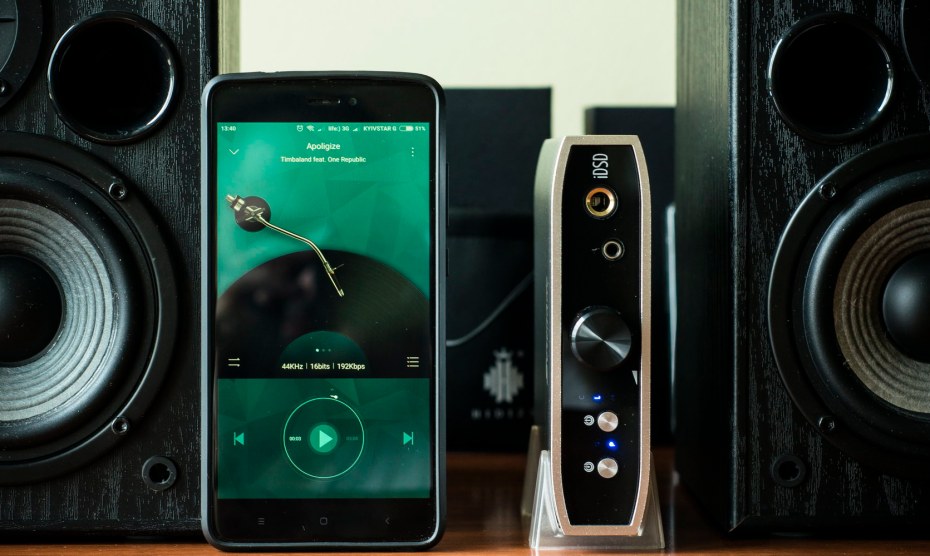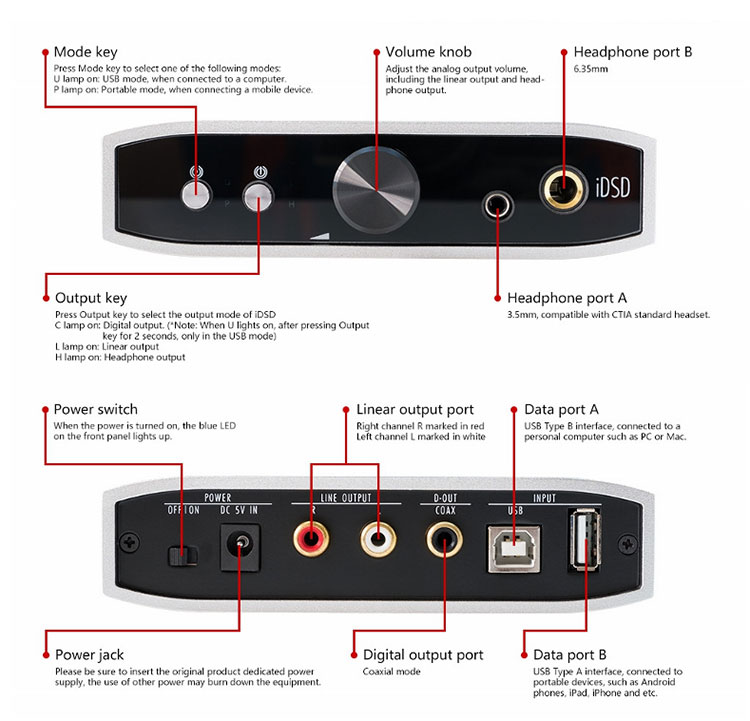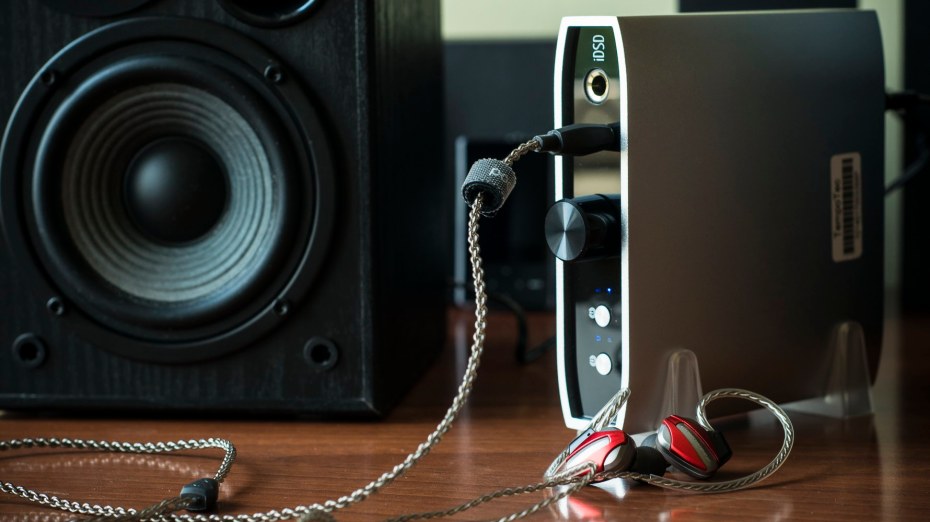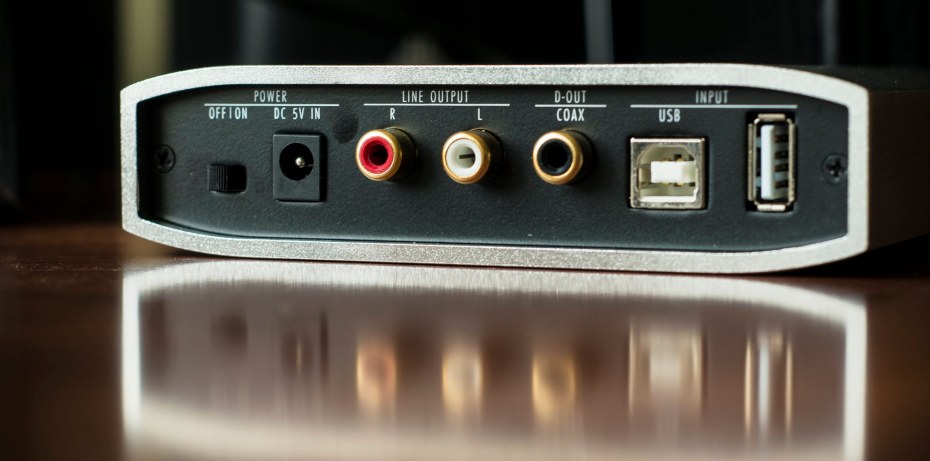Introduction
Tempotec is a veteran brand of audio products, whose catalog consists of several series:



On this occasion, the product I'm going to analyze, the Tempotec Serenade iDSD, is a very complete DAC/AMP, which has many possibilities of connection and use.
Among its features is the exclusive HiBy processor, capable of decoding DSD, APE, FLAC, WAV and MP3. It plays any DSD 64/128 format natively. You can also play high resolution music through the HiBy App from any IOS or Android device connected to it.
The method used for the digital transmission of the signal through the USB port is asynchronous, in order to offer a more precise sound, a larger scene and a lot of details.
The iDSD uses the AKM AK4490EQ DAC, the TPA6120A2 Ti amplifier and the LME 49720NA operational amplifier. In addition, this OpAmp can be replaced by another, as it is mounted in a socket that allows easy replacement.



Specifications



Packaging
The iDSD comes in a large cardboard box, which protects its packaging. Its dimensions are 260x213x72mm. This box is not generic, despite being the typical brown box, but contains the model name and description. In its interior already appears the packing "of exhibition". The upper part is decorated with the name of the series and the logo of the brand, as well as a pair of QR codes.
It opens like a chest and inside, the first thing you see is a sheet of white protective foam. Underneath it is the iDSD, embedded in a foam mold, also white. On top of it, there is a zip bag with the instruction booklet and the warranty. To the right of the protection mould, there is an elongated white box. Inside is the power supply, with European plug (a detail by the brand), a USB cable with gold-plated connectors (another great detail) and two supports to measure, to place the iDSD standing.
The dimensions of the iDSD, excluding the potentiometer and connectors, are: 122x128x32 mm
The packaging is fully adequate and the product is suitably protected. The content is the minimum required for the operation of the system. Nothing to object to in this respect.



Construction and Design
The iDSD has a striking, eye-catching design: a silver-plated aluminium housing, rounded at the edges, provides this effect. It has a black front and back. On the left front, there are two small silver buttons, one to select the USB input port (USB or Portable), and another to select the output (headphones, line or coaxial). In the middle is the potentiometer, a black plastic cylinder, which lacks any mark or notch, which indicates the level. On the right side, slightly downwards, is the 3.5mm headphone output. Finally, next to the letters iDSD, there is the 6.3mm headphone output.
At the rear, at both ends, two Philips screws can be seen. On the left side is the power switch. Next to it, on your right, is the power input. Following the order, are the two RCA outputs, conveniently gold plated. Then there is the coaxial output, also gold plated. Finally there are the USB inputs, first type B, for the connection with the PC, then the portable USB input, type A, vertically, for the connection of Smartphones IOS, Android, tablets, etc.
After unscrewing the two screws and removing the potentiometer nut, the iDSD can be disassembled to check its interior. And it is worth seeing, apart from the HiBy chip, the AKM AK4490EQ DAC, the TPA6120A2 Ti amplifier and the LME 49720NA operational amplifier, the use of Nichicon Gold series capacitors can be proudly observed, as well as the high level of the other components used.
The iDSD can be placed horizontally, as well as vertically, on the translucent plastic brackets that come with it. The outer casing acts as a radiator and, even though it is not very hot compared to other DACs I have, if the support surface is susceptible to heat damage, I suggest using the bases for its vertical arrangement. And, although these bases seem very simple, the vertical stability with these pieces is surprising.
In my opinion, both the design and the construction are excellent for their price. The only thing I miss is a small slot in the potentiometer knob to determine the volume level. This way you could avoid some damage to the IEMS after turning on the iDSD, because it is at a very high volume.



Connectivity
Connectivity is multiple, but simple. As inputs there is a USB port type B, for connection to PC, and a USB port type A, for connection to mobile devices. Mobile devices can also be connected via USB B, so they can even be charged.
For outputs you can use the front headphone sockets, the line RCA output or the digital coaxial output.
Both inputs and outputs are selectable via dedicated front buttons.
The main use that I have used for this review has been connected to my PC, through the USB-B port, using Foobar2000 as playback software. The driver used is the original one, in its version 3.26.0.
The installation of the driver is not complicated, I only recommend that you install the driver first and then connect the iDSD to the USB of the PC.






Measurements
Output 3.5mm 75Hz
Output 6.3mm 75Hz




Sound
The iDSD has a totally flat frequency response, but it also has an output impedance of approximately 10 Ω. As you can see, I have made some measurements on IEMs that I have, without reaching a specific conclusion, which allows to extract a fixed rule, on the incidence of this impedance on the IEMs tested. Compared to my reference DAC, the Burson Audio Playmate, the FR have hardly any differences in the low or medium part. Sometimes, the upper end seems more mitigated with the iDSD. But I must advance that my measurement method is not very accurate above 15kHz. The biggest difference can be seen in the Rose Mini2 MKII 2.0, where you can see a higher gain, starting above 200Hz.
As I have always maintained, a high output impedance is responsible for a modification in the frequency response of the connected IEMs. But, on this occasion, the incidence seems small enough to determine that it is negative. In this sense, it is also very important that the components close to the headphone output are very well chosen, so that they do not behave like filters that modify, in a fixed way, the frequency response of the connected headphones. On this occasion, this is not so, as you can see in the graphs above. This means that the electrical circuit has been very well thought out and tested, to offer maximum sound quality, without negatively interfering with the frequency response of each connected headphone.
The first impression I had after trying the iDSD, is a real sense of power and energy, a very vivid sound, strong, with punch, very funny and forceful. As I say, the sound shakes from the first listening, causing me a clear smile, moved by the aggressive character of the iDSD. But let no one understand aggressive, a sound out of control or hurtful. With this adjective I want to highlight the strength and vitality of the iDSD and move away from a calm or relaxed tone. The iDSD has been created to provoke great emotions. And that's not only demonstrated in the lower zone, but it's also perceived from above, because it offers a dynamic and marked sound, but with a treble that's a little harder than delicate. The mids are also very expressive, following the character of the iDSD, they have a clear tendency to offer a sensation of direct and big sound, with a lot of personality, marked details and good level of detail.
At scene level the level is remarkable, as is its separation, but it is not the strong point of the whole. It is clear that, in this sense, it is possible to change the OpAmp for others, with the intention of improving in this sense. For this occasion, I have used Burson Audio's OpAmp V5i, obtaining a greater clarity and gaining more scene, without losing the vigorous character of its sound.
But on this occasion, to better understand the sound of the iDSD, I have based myself on comparisons with my reference system, the Burson Audio Playmate, and then with another DAC of similar price, although smaller and more portable, the Sabaj DA3.




Comparisons
Burson Audio Playmate (399$)
The Playmate is worth more than three times, but we all know that the sound is not quantified in the same way as the price. By this I mean that, although the Playmate sound is a reference, the iDSD doesn't sound three times worse, that's clear.
In terms of construction, size, volume control and control panel, that's where part of the price difference lies. The volume control, in the Playmate, is digital and extremely precise, with two gain modes. It has the possibility of applying filters and a microphone input. In something that the iDSD beats the Playmate, it is in the two audio outputs (3.5mm and 6.3mm). When you open the inside of both, although both are very well organized and use excellent components, the Playmate stands out clearly, the use of transistors in class A offers a hard difference to overcome. In addition, the Playmate has 4 OpAmps versus 1 from the iDSD, as they are used in different phases of amplification. In the end, all this doesn't just translate to sound, but also to a greater amount of power offered by the Playmate.
The Burson offers a more neutral, wider and softer sound, somewhat removed from the energy sensation of the iDSD. This is something that is already demonstrated in the lower zone. The strength of the iDSD in the mid-low surpasses the Playmate feel in this sense. By contrast, the iDSD doesn't have such a deep extension, nor the detailed, smooth texture of the Burson. This tonic is repeated in both mid and treble.
The mid zone of the iDSD is perceived to be somewhat more congested than that offered by the Playmate, where the greater sound expansion offers greater naturalness and three-dimensionality in this zone. In this way, the elements are positioned with more space, being able to appreciate with more tranquillity, even closeness. In the treble, the iDSD is somewhat harder and more tense, where the Playmate is executed in a sweeter and more defined way, boasting an airy and separate sound, both in the midrange and in the upper zone.
But one of the great differences between the two is in the amplitude of the sound: the Playmate here stands out for its analytical ability and higher resolution, not that this means that its sound is analytical, but more balanced. Its higher level of detail and nuances, counteracts the energy of the iDSD, offering a wider width, a larger stage, versus the forcefulness and sound in the foreground of the iDSD.
If you had to sum up the sound of both in one word, the iDSD would be fun and the Playmate refined.
In terms of size, the Playmate is larger and designed to be positioned horizontally. Meanwhile, the iDSD is narrower, lower and deeper. In addition, it can be used horizontally or vertically, thanks to its supports. It also weighs less. The disadvantage of the iDSD is that in both positions, due to its low weight, it moves when the headphone jack is inserted. The Playmate, thanks to its weight and non-slip feet, offer a better experience in this regard.
The Burson's class A performance makes it much hotter than the iDSD, even if it's just moving IEMs, i.e. working at low power.
The iDSD potentiometer is analog and very sensitive to IEMs, that feeling of power is also determined by the sensitivity of the potentiometer: for IEMs, as little movement, the volume is raised a lot, is something that must be taken into account. The Playmate, apart from the fact that the volume is digital and goes by steps, which are shown on its display, has a much more gradual advance, in addition to having a gain selector, to even improve the sensitivity of the volume.






Sabaj DA3 (105$)
The DA3 is a small DAC, which uses two SABRE9018Q2C and has some big specifications. It is characterized by a low noise level, very low distortion, very good linearity and low output impedance (around 2 Ω). It has a balanced output and a small informative screen. All this in a very reduced size. In addition, it is designed for use as a DAC connected to the PC, as its bottom has a rubber EVA band to prevent slippage and improve grip. Without entering into any comparison, the sound is something particular, and is not exactly characterized by being sweet, but quite the opposite. On this occasion, it can be said that the sound of the DA3 is more aggressive, harder, less harmonious, less sweet and delicate, somewhat excessive, but very concrete, with a more sharp definition. And this is something that you can see with the passing of time. Depending on the IEMs used, the sound can be tiring, as it is not very friendly with delicate or analytical IEMs, because they enhance that sharp and harsh character it possesses. But with other more relaxed IEMs the sound is more pleasant.
This fact contrasts strongly with the sound of the iDSD, despite its power, the sound is not fatiguing, and, after a quick change between both DACs, the iDSD transmits much sweeter and a delicacy, which is appreciated.
In the lower zone both have a good representation, but the texture of the iDSD is softer and natural. This fact expands the bass in all senses, getting a more comfortable effect.
In the mid zone, the abrupt look of the DA3 remains, offering a clean sound, but less natural, comparatively speaking. Meanwhile, the iDSD stands out with its powerful, but velvety, sweeter and more harmonious sound. Both nuances can be observed taking the voices as a reference: in the DA3 they are perceived more tense, while the iDSD, even turning up the volume more, are kept at bay, always within the harmony.
In the upper zone is where the DA3 is shot: this part gives that more strident nuance that characterizes it. While iDSD is more polarized in the lower zone, offering great width and depth, but without underestimating the treble, nor much less, the details. That's the big difference: while the DA3 seems to offer a cooler, sharper sound, the level of detail and nuance is noticeably higher on the iDSD, providing an open, rich, separate, clean and deep sound. And the scene benefits from these aspects: the depth of the iDSD generates a larger and wider image, with greater height and length, more three-dimensional. The DA3's sharper, more concrete sound narrows, without expanding as naturally as iDSD does.
The great advantage of the DA3 is its size, it can become a perfect travel ally, with a more than decent sound quality. It also has an independent balanced output, which makes it even more attractive. But if you're looking for something more stationary, more powerful and more versatile, for little more, the iDSD provides a clearly better listening experience.




Conclusion
Without a doubt, the iDSD offers an excellent sound for its price. I don't think there are many DACs in this range that can give me as much satisfaction as this magnificent and versatile Tempotec. And that's something you feel from the first minute, no later comparison is necessary. Rarely am I so categorical in this sense: if someone asks me for a DAC around 125$, it is clear that I would recommend the Tempotec Serenade iDSD, as option number 1.
The iDSD has a great sound, based on a strong character, powerful, dynamic and forceful, very fun, but without losing control or sweetness. In addition, it offers two audio outputs, so you don't have to use adapters (and both are equal in sound and power), many options of use and connectivity, possibility of changing the OpAmp, a simple but very effective construction, using very high quality components, wisely conjugated, to maximize the final result. A luxury that is difficult to beat.



Headphones Used During the Analysis



Ratings
Purchase link
https://es.aliexpress.com/item/32905914455.html
You can read the full review in Spanish here:
https://hiendportable.com/2019/09/11/tempotec-serenade-idsd-review/
Tempotec is a veteran brand of audio products, whose catalog consists of several series:
- Fantasy: (DA II Plus, DP, B-HP). They are stationary products, focused on large size headphones and energy demand.
- Serenade: (iDSD, DA, PCI-E). They are products designed for use mainly with PCs, since they are external sound cards, even internal, with different functions each one of them.
- Sonata: These are portable amplifiers and DACs,
- Variations: (V1, V1A). This series is quite recent and consists of a player designed for connection to an amplifier or Bluetooth receiver system (V1) and a complete DAP with headphone output (V1-A).



On this occasion, the product I'm going to analyze, the Tempotec Serenade iDSD, is a very complete DAC/AMP, which has many possibilities of connection and use.
Among its features is the exclusive HiBy processor, capable of decoding DSD, APE, FLAC, WAV and MP3. It plays any DSD 64/128 format natively. You can also play high resolution music through the HiBy App from any IOS or Android device connected to it.
The method used for the digital transmission of the signal through the USB port is asynchronous, in order to offer a more precise sound, a larger scene and a lot of details.
The iDSD uses the AKM AK4490EQ DAC, the TPA6120A2 Ti amplifier and the LME 49720NA operational amplifier. In addition, this OpAmp can be replaced by another, as it is mounted in a socket that allows easy replacement.



Specifications
- PCM Support: 32-Bit/192KHz
- Frequency Response: 0Hz - 50KHz
- Stereo Isolation: 120dB
- Output impedance: 10 Ω
- THD + N: 120dB
- Output power: 75mW / 600 Ω



Packaging
The iDSD comes in a large cardboard box, which protects its packaging. Its dimensions are 260x213x72mm. This box is not generic, despite being the typical brown box, but contains the model name and description. In its interior already appears the packing "of exhibition". The upper part is decorated with the name of the series and the logo of the brand, as well as a pair of QR codes.
It opens like a chest and inside, the first thing you see is a sheet of white protective foam. Underneath it is the iDSD, embedded in a foam mold, also white. On top of it, there is a zip bag with the instruction booklet and the warranty. To the right of the protection mould, there is an elongated white box. Inside is the power supply, with European plug (a detail by the brand), a USB cable with gold-plated connectors (another great detail) and two supports to measure, to place the iDSD standing.
The dimensions of the iDSD, excluding the potentiometer and connectors, are: 122x128x32 mm
The packaging is fully adequate and the product is suitably protected. The content is the minimum required for the operation of the system. Nothing to object to in this respect.



Construction and Design
The iDSD has a striking, eye-catching design: a silver-plated aluminium housing, rounded at the edges, provides this effect. It has a black front and back. On the left front, there are two small silver buttons, one to select the USB input port (USB or Portable), and another to select the output (headphones, line or coaxial). In the middle is the potentiometer, a black plastic cylinder, which lacks any mark or notch, which indicates the level. On the right side, slightly downwards, is the 3.5mm headphone output. Finally, next to the letters iDSD, there is the 6.3mm headphone output.
At the rear, at both ends, two Philips screws can be seen. On the left side is the power switch. Next to it, on your right, is the power input. Following the order, are the two RCA outputs, conveniently gold plated. Then there is the coaxial output, also gold plated. Finally there are the USB inputs, first type B, for the connection with the PC, then the portable USB input, type A, vertically, for the connection of Smartphones IOS, Android, tablets, etc.
After unscrewing the two screws and removing the potentiometer nut, the iDSD can be disassembled to check its interior. And it is worth seeing, apart from the HiBy chip, the AKM AK4490EQ DAC, the TPA6120A2 Ti amplifier and the LME 49720NA operational amplifier, the use of Nichicon Gold series capacitors can be proudly observed, as well as the high level of the other components used.
The iDSD can be placed horizontally, as well as vertically, on the translucent plastic brackets that come with it. The outer casing acts as a radiator and, even though it is not very hot compared to other DACs I have, if the support surface is susceptible to heat damage, I suggest using the bases for its vertical arrangement. And, although these bases seem very simple, the vertical stability with these pieces is surprising.
In my opinion, both the design and the construction are excellent for their price. The only thing I miss is a small slot in the potentiometer knob to determine the volume level. This way you could avoid some damage to the IEMS after turning on the iDSD, because it is at a very high volume.



Connectivity
Connectivity is multiple, but simple. As inputs there is a USB port type B, for connection to PC, and a USB port type A, for connection to mobile devices. Mobile devices can also be connected via USB B, so they can even be charged.
For outputs you can use the front headphone sockets, the line RCA output or the digital coaxial output.
Both inputs and outputs are selectable via dedicated front buttons.
The main use that I have used for this review has been connected to my PC, through the USB-B port, using Foobar2000 as playback software. The driver used is the original one, in its version 3.26.0.
The installation of the driver is not complicated, I only recommend that you install the driver first and then connect the iDSD to the USB of the PC.






Measurements
Output 3.5mm 75Hz
- Open: 2.37 V
- 32: 1.81 V
- 100: 2.15 V
- 320: 2.30 V
Output 6.3mm 75Hz
- Open: 2.37 V
- 32: 1.81 V
- 100: 2.15 V
- 320: 2.30 V




Sound
The iDSD has a totally flat frequency response, but it also has an output impedance of approximately 10 Ω. As you can see, I have made some measurements on IEMs that I have, without reaching a specific conclusion, which allows to extract a fixed rule, on the incidence of this impedance on the IEMs tested. Compared to my reference DAC, the Burson Audio Playmate, the FR have hardly any differences in the low or medium part. Sometimes, the upper end seems more mitigated with the iDSD. But I must advance that my measurement method is not very accurate above 15kHz. The biggest difference can be seen in the Rose Mini2 MKII 2.0, where you can see a higher gain, starting above 200Hz.
As I have always maintained, a high output impedance is responsible for a modification in the frequency response of the connected IEMs. But, on this occasion, the incidence seems small enough to determine that it is negative. In this sense, it is also very important that the components close to the headphone output are very well chosen, so that they do not behave like filters that modify, in a fixed way, the frequency response of the connected headphones. On this occasion, this is not so, as you can see in the graphs above. This means that the electrical circuit has been very well thought out and tested, to offer maximum sound quality, without negatively interfering with the frequency response of each connected headphone.
The first impression I had after trying the iDSD, is a real sense of power and energy, a very vivid sound, strong, with punch, very funny and forceful. As I say, the sound shakes from the first listening, causing me a clear smile, moved by the aggressive character of the iDSD. But let no one understand aggressive, a sound out of control or hurtful. With this adjective I want to highlight the strength and vitality of the iDSD and move away from a calm or relaxed tone. The iDSD has been created to provoke great emotions. And that's not only demonstrated in the lower zone, but it's also perceived from above, because it offers a dynamic and marked sound, but with a treble that's a little harder than delicate. The mids are also very expressive, following the character of the iDSD, they have a clear tendency to offer a sensation of direct and big sound, with a lot of personality, marked details and good level of detail.
At scene level the level is remarkable, as is its separation, but it is not the strong point of the whole. It is clear that, in this sense, it is possible to change the OpAmp for others, with the intention of improving in this sense. For this occasion, I have used Burson Audio's OpAmp V5i, obtaining a greater clarity and gaining more scene, without losing the vigorous character of its sound.
But on this occasion, to better understand the sound of the iDSD, I have based myself on comparisons with my reference system, the Burson Audio Playmate, and then with another DAC of similar price, although smaller and more portable, the Sabaj DA3.




Comparisons
Burson Audio Playmate (399$)
The Playmate is worth more than three times, but we all know that the sound is not quantified in the same way as the price. By this I mean that, although the Playmate sound is a reference, the iDSD doesn't sound three times worse, that's clear.
In terms of construction, size, volume control and control panel, that's where part of the price difference lies. The volume control, in the Playmate, is digital and extremely precise, with two gain modes. It has the possibility of applying filters and a microphone input. In something that the iDSD beats the Playmate, it is in the two audio outputs (3.5mm and 6.3mm). When you open the inside of both, although both are very well organized and use excellent components, the Playmate stands out clearly, the use of transistors in class A offers a hard difference to overcome. In addition, the Playmate has 4 OpAmps versus 1 from the iDSD, as they are used in different phases of amplification. In the end, all this doesn't just translate to sound, but also to a greater amount of power offered by the Playmate.
The Burson offers a more neutral, wider and softer sound, somewhat removed from the energy sensation of the iDSD. This is something that is already demonstrated in the lower zone. The strength of the iDSD in the mid-low surpasses the Playmate feel in this sense. By contrast, the iDSD doesn't have such a deep extension, nor the detailed, smooth texture of the Burson. This tonic is repeated in both mid and treble.
The mid zone of the iDSD is perceived to be somewhat more congested than that offered by the Playmate, where the greater sound expansion offers greater naturalness and three-dimensionality in this zone. In this way, the elements are positioned with more space, being able to appreciate with more tranquillity, even closeness. In the treble, the iDSD is somewhat harder and more tense, where the Playmate is executed in a sweeter and more defined way, boasting an airy and separate sound, both in the midrange and in the upper zone.
But one of the great differences between the two is in the amplitude of the sound: the Playmate here stands out for its analytical ability and higher resolution, not that this means that its sound is analytical, but more balanced. Its higher level of detail and nuances, counteracts the energy of the iDSD, offering a wider width, a larger stage, versus the forcefulness and sound in the foreground of the iDSD.
If you had to sum up the sound of both in one word, the iDSD would be fun and the Playmate refined.
In terms of size, the Playmate is larger and designed to be positioned horizontally. Meanwhile, the iDSD is narrower, lower and deeper. In addition, it can be used horizontally or vertically, thanks to its supports. It also weighs less. The disadvantage of the iDSD is that in both positions, due to its low weight, it moves when the headphone jack is inserted. The Playmate, thanks to its weight and non-slip feet, offer a better experience in this regard.
The Burson's class A performance makes it much hotter than the iDSD, even if it's just moving IEMs, i.e. working at low power.
The iDSD potentiometer is analog and very sensitive to IEMs, that feeling of power is also determined by the sensitivity of the potentiometer: for IEMs, as little movement, the volume is raised a lot, is something that must be taken into account. The Playmate, apart from the fact that the volume is digital and goes by steps, which are shown on its display, has a much more gradual advance, in addition to having a gain selector, to even improve the sensitivity of the volume.






Sabaj DA3 (105$)
The DA3 is a small DAC, which uses two SABRE9018Q2C and has some big specifications. It is characterized by a low noise level, very low distortion, very good linearity and low output impedance (around 2 Ω). It has a balanced output and a small informative screen. All this in a very reduced size. In addition, it is designed for use as a DAC connected to the PC, as its bottom has a rubber EVA band to prevent slippage and improve grip. Without entering into any comparison, the sound is something particular, and is not exactly characterized by being sweet, but quite the opposite. On this occasion, it can be said that the sound of the DA3 is more aggressive, harder, less harmonious, less sweet and delicate, somewhat excessive, but very concrete, with a more sharp definition. And this is something that you can see with the passing of time. Depending on the IEMs used, the sound can be tiring, as it is not very friendly with delicate or analytical IEMs, because they enhance that sharp and harsh character it possesses. But with other more relaxed IEMs the sound is more pleasant.
This fact contrasts strongly with the sound of the iDSD, despite its power, the sound is not fatiguing, and, after a quick change between both DACs, the iDSD transmits much sweeter and a delicacy, which is appreciated.
In the lower zone both have a good representation, but the texture of the iDSD is softer and natural. This fact expands the bass in all senses, getting a more comfortable effect.
In the mid zone, the abrupt look of the DA3 remains, offering a clean sound, but less natural, comparatively speaking. Meanwhile, the iDSD stands out with its powerful, but velvety, sweeter and more harmonious sound. Both nuances can be observed taking the voices as a reference: in the DA3 they are perceived more tense, while the iDSD, even turning up the volume more, are kept at bay, always within the harmony.
In the upper zone is where the DA3 is shot: this part gives that more strident nuance that characterizes it. While iDSD is more polarized in the lower zone, offering great width and depth, but without underestimating the treble, nor much less, the details. That's the big difference: while the DA3 seems to offer a cooler, sharper sound, the level of detail and nuance is noticeably higher on the iDSD, providing an open, rich, separate, clean and deep sound. And the scene benefits from these aspects: the depth of the iDSD generates a larger and wider image, with greater height and length, more three-dimensional. The DA3's sharper, more concrete sound narrows, without expanding as naturally as iDSD does.
The great advantage of the DA3 is its size, it can become a perfect travel ally, with a more than decent sound quality. It also has an independent balanced output, which makes it even more attractive. But if you're looking for something more stationary, more powerful and more versatile, for little more, the iDSD provides a clearly better listening experience.




Conclusion
Without a doubt, the iDSD offers an excellent sound for its price. I don't think there are many DACs in this range that can give me as much satisfaction as this magnificent and versatile Tempotec. And that's something you feel from the first minute, no later comparison is necessary. Rarely am I so categorical in this sense: if someone asks me for a DAC around 125$, it is clear that I would recommend the Tempotec Serenade iDSD, as option number 1.
The iDSD has a great sound, based on a strong character, powerful, dynamic and forceful, very fun, but without losing control or sweetness. In addition, it offers two audio outputs, so you don't have to use adapters (and both are equal in sound and power), many options of use and connectivity, possibility of changing the OpAmp, a simple but very effective construction, using very high quality components, wisely conjugated, to maximize the final result. A luxury that is difficult to beat.



Headphones Used During the Analysis
- DB Monroe
- Auglamour RT-3
- Moodrop Kanas Pro
- Smabat ST-10
- Rose Mini2 MKII 2.0
- NS Audio NS3
- ISN Rambo
- SoundMagic HP150



Ratings
- Construction and Design: 90
- Accessories: 70
- Connectivity: 90
- Sound: 92
- Quality/Price: 95
Purchase link
https://es.aliexpress.com/item/32905914455.html
You can read the full review in Spanish here:
https://hiendportable.com/2019/09/11/tempotec-serenade-idsd-review/
